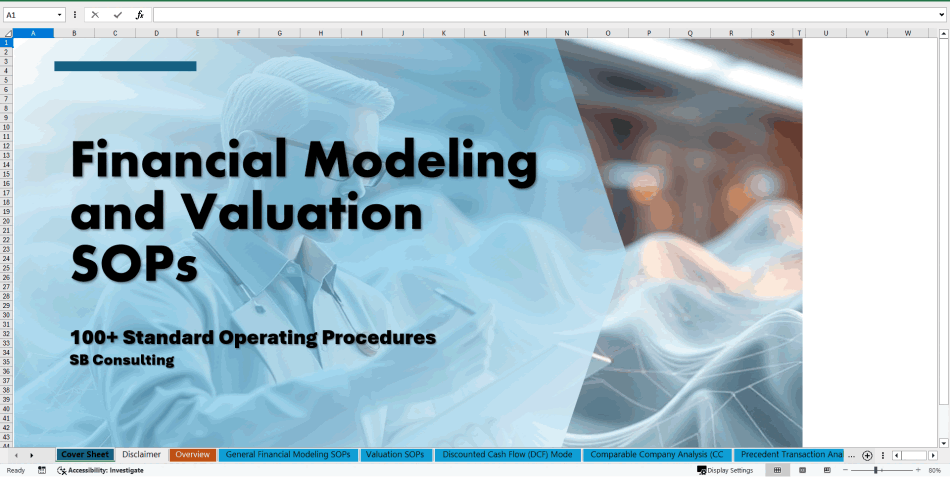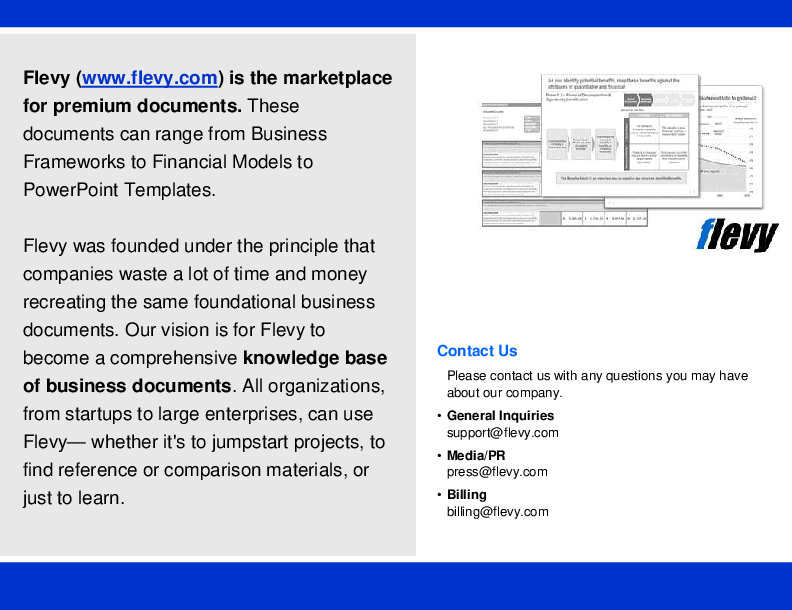100+ Financial Modeling & Valuation SOPs (Excel XLSX)
Excel (XLSX)
BENEFITS OF THIS EXCEL DOCUMENT
- Offers step-by-step guidance for performing valuations using DCF, CCA, and PTA methodologies.
- Delivers industry-specific standards and advanced modeling techniques to ensure compliance and precision.
- Provides a comprehensive framework for building accurate and reliable financial models in Excel.
FINANCIAL MODELING EXCEL DESCRIPTION
Curated by McKinsey-trained Executives
🚀 Dominate Financial Modeling & Valuation with the Ultimate 100+ SOP Excel Package! 🚀
Stop wasting countless hours hunting for best practices in financial modeling and valuation. Our comprehensive Excel SOP package gives you everything you need—over 100 professionally-crafted Standard Operating Procedures covering every aspect of financial analysis, modeling, and valuation. Whether you're an investment banker, corporate finance professional, analyst, or CFO, this is your all-in-one blueprint to build bulletproof financial models, drive accurate valuations, and impress stakeholders every single time.
This is not just a template—it's a complete financial modeling and valuation system. From general model structure to advanced scenario analysis, from discounted cash flows to cross-border M&A, every SOP is battle-tested, detailed, and ready-to-implement in Excel.
What's Inside the 100+ SOPs Package?
General Financial Modeling SOPs
1. Model Structure and Organization
2. Standardization of Financial Statements Layout
3. Excel Formatting and Best Practices
4. Use of Color Codes in Financial Models
5. Model Input Assumptions and Sensitivity Analysis
6. Key Metrics and Performance Indicators
7. Forecasting Methodologies
8. Discount Rate Selection in Models
9. Handling of Non-Operating Assets and Liabilities
10. Treatment of Off-Balance Sheet Items
11. Treatment of One-Time and Nonrecurring Items
12. Error Checking and Debugging in Financial Models
13. Documentation and Version Control in Models
14. Building Dynamic and Flexible Models
15. Model Review and Quality Assurance Procedures
Valuation SOPs
16. Definition of Value in Different Valuation Contexts
17. Valuation Method Selection Criteria
18. Adjusting for Market and Economic Conditions
19. Terminal Value Calculation Methodology
20. Incorporating Control Premiums or Discounts
21. Treatment of Minority Interests in Valuations
22. Sensitivity and Scenario Analysis in Valuation
23. Use of Public vs Private Company Comparisons
24. Reconciliation of Different Valuation Approaches
25. Impairment Testing and Valuation Adjustments
26. Data Source Validation and Credibility Checks
27. Treatment of Intangible Assets in Valuation
28. International Valuation Standards (IVS)
29. Impact of Debt Structure on Valuation
30. Valuation for Tax Purposes
Discounted Cash Flow (DCF) Model SOPs
31. Assumptions for Revenue and Expense Projections
32. Tax Rate Assumptions and Adjustments
33. Depreciation and Amortization Schedules in DCF
34. Capital Expenditure and Working Capital Adjustments
35. Forecast Period and Terminal Value Assumptions
36. Free Cash Flow Calculation Methodology
37. Determining the Appropriate Discount Rate
38. WACC Calculation and Inputs
39. Sensitivity Analysis for Key DCF Assumptions
40. Treatment of Minority Interests and Noncontrolling Interests
41. Debt and Equity Treatment in DCF Models
42. Adjustments for Excess Cash or Non-Core Assets
43. Incorporating Inflation Assumptions
44. Use of Scenario Analysis in DCF Models
45. Final Valuation Reconciliation from DCF
46. Terminal Growth Rate Assumptions in DCF
47. Analyzing DCF Model Results and Outputs
48. Validation of Cash Flow Assumptions
Comparable Company Analysis (CCA) SOPs
49. Selection of Peer Group Companies
50. Adjustments for Non-Comparable Items
51. Enterprise Value Calculation in CCA
52. Use of Trading Multiples in CCA
53. Adjusting for Market Conditions in CCA
54. EBITDA and EBIT Comparisons in CCA
55. Adjusting for Accounting Differences in CCA
56. Currency Conversion and Adjustments in CCA
57. Importance of Industry-Specific Multiples
58. Normalizing Financial Data for CCA
59. Sensitivity Analysis in Comparable Company Analysis
60. Comparable Company Selection Criteria and Methodology
61. Review of Historical and Projected Data in CCA
62. Handling of Excess Cash in CCA
63. Adjusting for Capital Structure Differences
64. Benchmarking Industry Trends and Ratios
65. Peer Group Weighting in Valuation
Precedent Transaction Analysis (PTA) SOPs
66. Selection of Relevant Transactions
67. Adjustments for Different Deal Structures
68. Calculation of Transaction Multiples
69. Adjusting for Market Conditions in PTA
70. Impact of Synergies in Precedent Transaction Analysis
71. Inclusion of Control Premiums in PTA
72. Transaction Date Adjustments
73. Treatment of Debt and Equity in Transactions
74. Impact of Transaction Fees and Costs
75. Public vs Private Transaction Comparisons
76. Adjustments for Market Liquidity in PTA
77. Sensitivity Analysis in Precedent Transaction Models
78. Normalizing Data from Precedent Transactions
79. Cross-border Transaction Adjustments
80. Using PTA for M&A Valuation Purposes
81. Selecting the Most Comparable Transactions
Financial Ratio Analysis SOPs
82. Liquidity Ratios Calculation and Interpretation
83. Profitability Ratios Calculation and Analysis
84. Leverage Ratios Analysis
85. Efficiency Ratios and Asset Utilization
86. Valuation Ratios (P/E, P/B, EV/EBITDA)
87. Coverage Ratios and Debt Service Analysis
88. Benchmarking Ratios to Industry Standards
89. Historical vs Projected Ratio Comparison
90. Seasonality Adjustments in Financial Ratios
91. Impact of Non-Recurring Items on Ratios
92. Using Ratios in Credit and Risk Analysis
93. Debt Covenant Compliance Ratios
94. Reconciliation of Different Ratio Definitions
95. Adjusting for Non-GAAP Financial Metrics
96. Ratios for Different Business Sectors (e.g., Banking, Real Estate)
97. Use of Ratio Analysis in Financial Forecasting
98. Identification of Outliers in Ratio Trends
99. Adjustments for Inflation and Currency in Ratios
Industry-Specific Financial Standards SOPs
100. Real Estate Financial Modeling Standards
101. Energy Sector Financial Modeling Standards
102. Retail Industry Financial Modeling Standards
103. Financial Modeling for Tech Startups
104. Banking Industry Modeling and Standards
105. Healthcare Industry Financial Standards
106. Media and Entertainment Industry Standards
107. Infrastructure Project Financial Modeling
108. Agriculture and Commodity Industry Modeling
109. Financial Modeling for Private Equity
110. Real Estate Investment Trust (REIT) Standards
111. Automobile Industry Financial Standards
112. Pharmaceuticals Financial Modeling Standards
113. Financial Modeling for SaaS Companies
114. Financial Modeling for M&A Transactions
115. Financial Modeling for Venture Capital Valuations
116. Financial Modeling for Manufacturing Companies
117. Telecommunications Industry Financial Standards
Advanced Financial Modeling SOPs
120. Multi-Scenario and Stress Testing in Models
121. Use of Monte Carlo Simulation in Financial Models
122. Forecasting and Model Adjustments Post-Transaction
123. Developing Complex Financial Derivative Models
124. Creating Models for Mergers and Acquisitions
125. Tax Modeling and Implications
126. Integration of Alternative Investments into Models
127. Modeling of Cross-Border Transactions and FX Risks
128. Building Real-Time Financial Models for Trading
129. Automation in Financial Modeling and Reporting
130. Quantitative Finance and Stochastic Modeling Techniques
131. Model Optimization Techniques
132. Scenario Planning in Strategic Financial Modeling
133. Incorporating ESG Factors in Financial Models
134. Financial Modeling in Bankruptcy and Restructuring
135. Impact of Environmental, Social, and Governance (ESG) Factors in Valuations
Modeling for Financial Reporting and Compliance SOPs
136. Consolidated Financial Statements Modeling
137. IFRS vs GAAP Adjustments in Models
138. SEC Filings and Financial Modeling Requirements
139. Compliance with Sarbanes-Oxley Act in Financial Modeling
140. Preparing Financial Models for Public Offering
141. Adjustments for Accounting Standards in Financial Models
142. Revenue Recognition Adjustments
143. Lease Accounting Adjustments (ASC 842)
144. Earnings Per Share (EPS) Calculation Methodology
145. Deferred Taxes and Tax Accounting in Models
146. Financial Reporting Standards and External Audits
147. Fair Value Accounting and Adjustments in Models
148. Reporting Financial Data for Regulatory Bodies
149. Reconciliation of Financial Statements with Models
150. Using Financial Models to Support Financial Reporting and Auditing
💥 Why This Package is a Game-Changer:
• 100% Excel-ready templates with step-by-step SOPs
• Covers general, industry-specific, advanced, and compliance-focused financial modeling
• Built to save weeks of work, reduce errors, and standardize your models
• Perfect for analysts, bankers, CFOs, consultants, and private equity professionals
Stop guessing. Stop wasting time. Own the financial modeling and valuation process like a pro with our 100+ SOP Excel package.
Key Words:
Strategy & Transformation, Growth Strategy, Strategic Planning, Strategy Frameworks, Innovation Management, Pricing Strategy, Core Competencies, Strategy Development, Business Transformation, Marketing Plan Development, Product Strategy, Breakout Strategy, Competitive Advantage, Mission, Vision, Values, Strategy Deployment & Execution, Innovation, Vision Statement, Core Competencies Analysis, Corporate Strategy, Product Launch Strategy, BMI, Blue Ocean Strategy, Breakthrough Strategy, Business Model Innovation, Business Strategy Example, Corporate Transformation, Critical Success Factors, Customer Segmentation, Customer Value Proposition, Distinctive Capabilities, Enterprise Performance Management, KPI, Key Performance Indicators, Market Analysis, Market Entry Example, Market Entry Plan, Market Intelligence, Market Research, Market Segmentation, Market Sizing, Marketing, Michael Porter's Value Chain, Organizational Transformation, Performance Management, Performance Measurement, Platform Strategy, Product Go-to-Market Strategy, Reorganization, Restructuring, SWOT, SWOT Analysis, Service 4.0, Service Strategy, Service Transformation, Strategic Analysis, Strategic Plan Example, Strategy Deployment, Strategy Execution, Strategy Frameworks Compilation, Strategy Methodologies, Strategy Report Example, Value Chain, Value Chain Analysis, Value Innovation, Value Proposition, Vision Statement, Corporate Strategy, Business Development, Busienss plan pdf, business plan, PDF, Biusiness Plan DOC, Bisiness Plan Template, PPT, Market strategy playbook, strategic market planning, competitive analysis tools, market segmentation frameworks, growth strategy templates, product positioning strategy, market execution toolkit, strategic alignment playbook, KPI and OKR frameworks, business growth strategy guide, cross-functional strategy templates, market risk management, market strategy PowerPoint dec, guide, ebook, e-book ,McKinsey Change Playbook, Organizational change management toolkit, Change management frameworks 2025, Influence model for change, Change leadership strategies, Behavioral change in organizations, Change management PowerPoint templates, Transformational leadership in change, supply chain KPIs, supply chain KPI toolkit, supply chain PowerPoint template, logistics KPIs, procurement KPIs, inventory management KPIs, supply chain performance metrics, manufacturing KPIs, supply chain dashboard, supply chain strategy KPIs, reverse logistics KPIs, sustainability KPIs in supply chain, financial supply chain KPIs, warehouse KPIs, digital supply chain KPIs, 1200 KPIs, supply chain scorecard, KPI examples, supply chain templates, Board SOPs, Board Management Template, Board Governance Excel Template, Corporate Governance SOPs, Board Meeting Procedures, Board Oversight Toolkit, Governance SOP Pack, Risk and Compliance SOPs, Strategic Board Oversight Framework, Audit Committee Templates, Board Governance Best Practices.
NOTE: Our digital products are sold on an "as is" basis, making returns and refunds unavailable post-download. Please preview and inquire before purchasing. Please contact us before purchasing if you have any questions! This policy aligns with the standard Flevy Terms of Usage.
Got a question about the product? Email us at support@flevy.com or ask the author directly by using the "Ask the Author a Question" form. If you cannot view the preview above this document description, go here to view the large preview instead.
Source: Best Practices in Financial Modeling Excel: 100+ Financial Modeling & Valuation SOPs Excel (XLSX) Spreadsheet, SB Consulting








